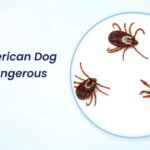Yes, male dog ticks can carry diseases. They transmit pathogens that can cause illness in dogs and humans.
Dog ticks, including male ones, are vectors for various diseases. These parasites latch onto hosts and can spread pathogens through their bites. Some common diseases transmitted by dog ticks include Lyme disease, Rocky Mountain spotted fever, and Ehrlichiosis. It’s crucial to regularly check your dog for ticks, especially after outdoor activities.
Early detection and removal of ticks can prevent disease transmission. Using preventive measures like tick collars, spot-on treatments, and keeping your yard tick-free can help protect your pets and family. Always consult your veterinarian for the best tick prevention strategies tailored to your dog’s needs.
Types Of Diseases Carried By Ticks
Dog ticks, including male dog ticks, can carry diseases that affect both pets and humans. These diseases can cause severe health issues if not treated promptly. Understanding the types of diseases carried by ticks is crucial for maintaining the health of your pets and family.
Lyme Disease And Its Symptoms
Lyme disease is one of the most common diseases transmitted by ticks. It is caused by the bacterium Borrelia burgdorferi. Male dog ticks can carry this bacterium and transmit it through their bite.
Symptoms of Lyme disease in dogs include:
- Fever
- Lethargy
- Loss of appetite
- Swollen joints
- Lameness
In severe cases, dogs may develop kidney problems, and in rare cases, heart or nervous system issues. Early detection and treatment with antibiotics are essential for a full recovery.
Preventing Lyme disease involves regular tick checks, using tick prevention products, and keeping your yard tick-free.
Rocky Mountain Spotted Fever
Rocky Mountain Spotted Fever (RMSF) is another serious disease carried by ticks. It is caused by the bacterium Rickettsia rickettsii. Although more common in humans, dogs can also contract RMSF.
Symptoms of RMSF in dogs include:
- Fever
- Vomiting
- Diarrhea
- Loss of appetite
- Swelling in the limbs
In more severe cases, dogs may experience neurological issues, such as seizures or difficulty walking. Immediate veterinary care is crucial for dogs showing signs of RMSF. Treatment typically involves a course of antibiotics.
To reduce the risk of RMSF, it is important to use tick prevention products and perform regular tick checks on your pets.
Ehrlichiosis And Anaplasmosis
Ehrlichiosis and Anaplasmosis are two separate diseases that share similar symptoms and are both carried by ticks. Ehrlichiosis is caused by the bacterium Ehrlichia canis, while Anaplasmosis is caused by Anaplasma phagocytophilum.
Symptoms of Ehrlichiosis in dogs include:
- Fever
- Weight loss
- Swollen lymph nodes
- Respiratory distress
- Bleeding disorders
Symptoms of Anaplasmosis in dogs include:
- Fever
- Joint pain
- Lethargy
- Loss of appetite
- Neurological signs
Both diseases can be treated with antibiotics if detected early. Preventing tick bites through regular use of tick preventatives and frequent checks is key to protecting your pets from these diseases.
How Male Dog Ticks Affect Disease Transmission
Dog ticks are common parasites that can pose serious health risks to pets and humans. Understanding how male dog ticks affect disease transmission is crucial. While both male and female ticks are vectors of disease, they play different roles in the transmission process. This blog post explores the differences between male and female ticks and the impact of their feeding behavior on disease transmission.
Differences Between Male And Female Ticks
Male and female ticks differ in several ways, from their appearance to their feeding habits. These differences influence their role in disease transmission. Here are some key distinctions:
- Size and Appearance: Female ticks are generally larger than males. Males have a more mottled appearance due to their smaller scutum (shield).
- Feeding Duration: Female ticks attach to hosts for longer periods, often several days, to engorge and lay eggs. Males feed for shorter durations.
- Reproductive Roles: Only female ticks lay eggs. Males focus on mating and feeding intermittently.
The table below summarizes these differences:
| Feature | Male Ticks | Female Ticks |
|---|---|---|
| Size | Smaller | Larger |
| Appearance | Mottled | Uniform |
| Feeding Duration | Short | Long |
| Reproductive Role | Mating | Egg-laying |
The Impact Of Tick Feeding Behavior
The feeding behavior of ticks significantly impacts disease transmission. Both males and females feed on blood, but their habits differ, affecting how diseases spread.
- Attachment Time: Female ticks attach for extended periods, increasing the risk of transmitting diseases such as Lyme disease and Rocky Mountain spotted fever.
- Host Interaction: Males often feed on multiple hosts, increasing the likelihood of picking up and spreading pathogens.
- Feeding Sites: Males may feed on less exposed body areas, making them harder to detect and remove.
Here is a closer look at how these behaviors impact disease transmission:
| Behavior | Impact on Disease Transmission |
|---|---|
| Extended Attachment | Higher disease transmission risk |
| Multiple Hosts | Increased pathogen spread |
| Feeding Sites | Harder detection and removal |
Understanding these behaviors helps in developing effective strategies to control tick populations and reduce the risk of tick-borne diseases.
Prevention Strategies For Tick-borne Diseases
Male dog ticks can carry diseases that affect both pets and humans. Ensuring your furry friend stays tick-free is essential. Implementing effective prevention strategies for tick-borne diseases can protect your dog from serious health issues. Below are some key strategies to keep your dog safe from ticks and the diseases they carry.
Regular Tick Checks And Grooming
Regular tick checks and grooming are vital to keep your dog healthy. After outdoor activities, inspect your dog’s fur thoroughly. Pay attention to areas like the neck, ears, and underbelly.
Here are some steps to follow:
- Inspect your dog daily: Use your fingers to feel for bumps or use a fine-toothed comb to brush through their fur.
- Focus on hidden areas: Ticks often hide in less visible places like between toes and inside ears.
- Remove ticks immediately: Use tweezers or a tick removal tool to gently pull the tick out.
- Clean the bite area: Disinfect the area with antiseptic to prevent infection.
Grooming your dog also helps in early detection of ticks. Regular baths and brushing can reduce the chances of tick infestation.
Here’s a simple table for quick tick-check tips:
| Area | Action |
|---|---|
| Neck and Ears | Inspect and feel for bumps |
| Underbelly | Comb through fur |
| Toes and Armpits | Check between toes and armpits |
Use Of Tick Preventatives
Using tick preventatives is crucial in protecting your dog from tick-borne diseases. There are various products available that can keep ticks at bay.
Consider these options:
- Collars: Tick collars release chemicals that repel ticks. They are easy to use and effective for several months.
- Sprays: Tick sprays can be applied directly to your dog’s coat. They provide immediate protection and are useful for spot treatments.
- Medications: Oral or topical medications can prevent tick infestations. These are often given monthly and can be highly effective.
Consult your veterinarian to choose the best preventative for your dog. Some products may work better depending on your dog’s size, breed, and health condition.
Here’s a comparison table for tick preventatives:
| Product | Application | Duration |
|---|---|---|
| Collars | Wear around neck | Up to 8 months |
| Sprays | Apply on coat | Few days to weeks |
| Medications | Oral or topical | Monthly |
Using a combination of regular tick checks, grooming, and tick preventatives can significantly reduce the risk of tick-borne diseases in your dog.
Frequently Asked Questions
Do Male Dog Ticks Carry Diseases?
Yes, male dog ticks can carry diseases. They transmit pathogens through their bites. Even though they feed less than females, they can still spread illnesses like Lyme disease and Rocky Mountain spotted fever.
What Diseases Do Male Dog Ticks Spread?
Male dog ticks spread diseases such as Lyme disease and Rocky Mountain spotted fever. These diseases can affect both dogs and humans, making tick prevention crucial for pet owners.
How Can You Identify A Male Dog Tick?
You can identify a male dog tick by its smaller size and less engorged body. Male ticks also have a different color pattern compared to females, often appearing darker.
Are Male Dog Ticks Dangerous To Dogs?
Yes, male dog ticks are dangerous to dogs. They can transmit various diseases through their bites, causing serious health issues. Regular tick checks and preventive measures are essential.
Conclusion
Male dog ticks can indeed carry diseases. It’s crucial to check your pets regularly for ticks. Early detection and prompt removal reduce the risk of disease transmission. Use preventive measures to protect your furry friends. Stay informed and keep your pets safe from tick-borne illnesses.

I’m David, an expert contributor and writer, with two furry friends of my own, I know the challenges of raising and caring for dogs. From training to nutrition and health, my goal is to provide valuable insights and advice to help create strong bonds and happy, healthy lives. Find me in Twitter.




